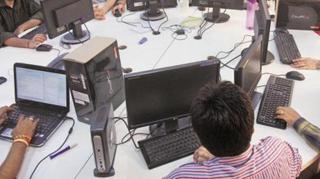A suicide is always a crushing tragedy. It is legally considered to be extreme and irrational, as we all believe that human life is our most precious triumph. Ironically, the suicide note always argues the opposite: That there are rational motives which compel people to end their lives. Such is what we learn from the young 25-year-old IT engineer Gopalakrishna Durga Prasad who jumped off the fourth floor of a Pune hotel because “in IT there is no job security. I’m worried a lot about my family”.
There are statistics that can now back the claim that jobs in India’s once most dynamic service sector are not only drying up but that a range of new (automation) technologies are rapidly eliminating or rendering redundant thousands of existing positions. But is it not also the case India could also be the most happening place for a 25-year-old trained IT professional to turn a ‘self-employed risk-taking start up entrepreneur’? Why did this not occur to the aspiring Durgaprasad? How real, we should ask, have problems of rationality and reason become in India today?
Take demonetisation, for instance. To a rational economist, ‘notebandi’ appeared irrational. Politically, however, for vast swathes of the Indian underclass and for those who were left out of India’s economic growth story over the past two decades, the sudden elimination of high-value currency notes ― which they never had in plenty — appeared like a real and rational way of ending corruption and ill-gotten wealth. No amount of haranguing about economic theory, it seems, could unsettle good old fashioned common sense conviction.
For the stock market in India, on the other hand, its moment of ‘irrotational exbureance’ is being widely celebrated. This past week, both the 30-share Sensex and the broader Nifty index touched a new high after a strong weeks-long rally in stock prices. The Sensex, which on Thursday crossed the 32,000-mark for the first time, has risen more than 3,000 points, or 10%, over the past 12 weeks, a period that broadly overlaps with the first quarter of the current financial year.
This turnaround in market sentiments has, in fact, no connect with the real economy. Manufacturing growth has slipped further from 2.4%in April to 1.8% in May; exports fell from $246 billion in April to $240 billion in May and $235 billion in June while a demonetisation-induced deflation in food prices threatens to undermine rural demand and a speedier economic recovery. Add to it the supply-chain disruptions following the implementation of the Goods and Services tax, which has yet to come good on its claim of being independent India’s biggest tax reform.
In the weeks to follow, most companies are expected to report weaker quarterly earnings with a subdued outlook for the rest of the year. Tata Consultancy Services (TCS) opened the calendar, reporting a 10% year-on-year drop in net profit and a net decline in its workforce for the first time since 2010. TCS, the biggest employer of software engineers in the country, also announced it would shut down its Lucknow centre and “relocate” the 2,000-odd staff working there. That’s just one sign – more will follow – of how the job market and the economy on the whole might be going from bad to worse. Global investors know it. That’s why they have not been buying much in Indian equities – FIIs have been net sellers so far in July. Their growing disillusionment perhaps manifests in how publications such as The Economist and The New York Times have chosen to report the India story in recent times.
Yet, just like the underclass and notebandi, a spectrum of domestic investors from the middle to upper classes want to sustain the irrational belief that the stock market need not have anything to do with the real economy. And very much like the common sense against the rich in the case of demonetisation, the irrational exuberance for the get-rich fantasy is hard to argue against.





Leave a reply